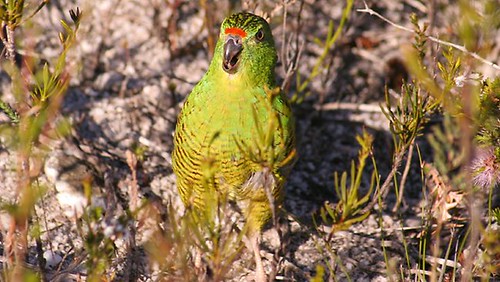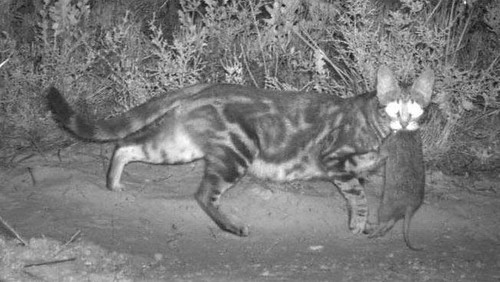Cats have decimated populations of many endangered birds
 ENDANGERED: Western ground parrots are being driven to extinction by feral cats.June 2011: A feral cat control trial in Western Australia's south coast national parks has shown baiting could prove effective in reducing feral cat populations in temperate regions.
ENDANGERED: Western ground parrots are being driven to extinction by feral cats.June 2011: A feral cat control trial in Western Australia's south coast national parks has shown baiting could prove effective in reducing feral cat populations in temperate regions.
Building on the success of feral cat baiting in WA's arid and semi-arid regions, scientists and conservation officers from the Department of Environment and Conservation (DEC) are now at the forefront of an effort to save the critically endangered western ground parrot and other native animals.
DEC's Cameron Tiller said the western ground parrot is found only in Fitzgerald River and Cape Arid national parks, with fewer than 140 individuals known to exist in the wild, and if the current decline is not halted, this species could become the first bird extinction on mainland Australia since the early 1930s.
Cats have been notoriously difficult to control
‘Feral cat predation has decimated this species as well as local populations of chuditch, dibblers and other vulnerable fauna, and in the past cats have been notoriously difficult to control as they will not take traditional dried meat baits used for foxes,' Mr Tiller said.
The bushfire in Cape Arid National Park earlier this year that burnt about 1000ha of western ground parrot habitat makes predator control even more important for the few remaining populations of this species.
‘After a five-year trial of non-toxic baits in Fitzgerald River National Park, we had enough data last year to air drop Eradicat 1080 poison baits over the park.
 KILLERS: Feral cats have decimated many native wildlife speciesHalf the cats were killed in two weeks
KILLERS: Feral cats have decimated many native wildlife speciesHalf the cats were killed in two weeks
‘This year we repeated the trial in Cape Arid National Park, testing out different baits and methods, and found that of 18 cats radio-collared, eight were killed by the baits, and monitoring of cat activity on sand pads showed a significant decline after baiting.
‘This shows that cat baiting is working, but that there is a lot more to do to refine the way we deliver the baits, which baits we use and how these baits are made up.
Baiting is more successful in dry areas
‘We believe that damp conditions immediately after dropping the baits may have prevented a greater knockdown of feral cats, and we know that baiting in drier areas is more effective because the baits don't spoil as rapidly.
‘Trials next year will focus on delivering baits during mid to late summer to determine whether this will achieve a greater result in our efforts to control feral cats in high value fauna conservation reserves on the south coast.'
As part of a wider approach to conserving the western ground parrot, a small number of birds have been captured for husbandry research and to establish whether captive breeding could be used as a risk mitigation measure, so populations can be re-established where predator control has been effective.